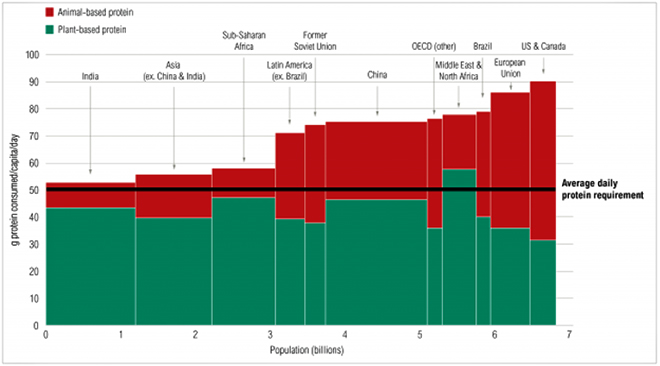
The ‘building blocks’ of life, proteins are not only lacking in the Indian diet, but often overlooked. India’s protein consumption is much lower than the 48 gms/day that is recommended by the Indian Council of Medical Research (ICMR). The recommended dietary allowance of protein for an average Indian adult is 0.8 to 1 gm per kg body weight, however, the average intake is about 0.6 gm per kg body weight.
A 2017 survey shows that 73 percent of Indians are deficient in protein while above 90 percent are unaware of the daily requirement of protein. A recent survey across 16 cities in India on perception, knowledge and consumption of protein found a gap in the knowledge of quality protein in daily diets. Various myths surround protein consumption with 85 percent believing it leads to weight gain.
Globally, protein consumption is on the rise, averaging at 68 gm per person per day (Figure 1). India has the lowest average protein consumption (at 47 gm per person per day) as compared to other Asian countries as well as developed nations.
Figure 1: Protein consumption around the world
 Source: Ranganathan, J. et al. 2016. “Shifting Diets for a Sustainable Food Future.” Working Paper, Installment 11 of Creating a Sustainable Food Future. Washington, DC: World Resources Institute
Source: Ranganathan, J. et al. 2016. “Shifting Diets for a Sustainable Food Future.” Working Paper, Installment 11 of Creating a Sustainable Food Future. Washington, DC: World Resources Institute
The National Sample Survey 2011-12 indicates a decline in the per capita protein consumption in both urban (4 percent) and rural (11 percent) areas. Indian diets are predominantly cereal-based, and 60 percent of protein is derived from cereals that have poor digestibility and quality. A study conducted across eight Indian cities found that 71 percent of individuals between the ages of 30 to 55 years suffer from poor muscle health. Data indicates variations between states as well as cities, for instance Lucknow—at 81 percent has the highest percentage of individuals who have poor muscle mass, while Delhi—at 64 percent has a much lesser percentage.
The EAT Lancet-Commission report shows that Indians consume more simple carbohydrates and less complex carbohydrates, proteins, and fruits and vegetables in their diets. The Indian Consumer Market 2020 shows high monthly expenditure on cereals, processed foods with only one-third of the food budget being spent on protein-rich foods.
India is also facing the double burden of malnutrition, with 38 percent undernutrition (46.6 million) in children under the age of five and about 15 percent obesity and overweight (14.4 million). There is variation in obesity prevalence across age, gender, socio-economic status with ICMR-INDIAB study showing that the prevalence of obesity ranges from 11.8 to 31.3 percent for India. With the rise in non-communicable diseases, it is important to have a balance in the quality and quantity of macronutritients. There has been a declining trend in the consumption of protective foods like pulses and milk. The inclusion of high-protein foods in a diet has been strongly associated with improving insulin response and reducing diabetes.
The Food and Agricultural Organisation calls for a focus on an economic stimulus for the proper functioning of the food supply chain and to provide access to nutritious food to the needy during the pandemic. NITI Aayog has been pushing for protein-rich foods—both plant and animal protein—to be included in the public distribution system, evidenced in the government’s relief package for poor and vulnerable families in the wake of the pandemic.
India’s nutrition programmes, through the Public Distribution System (PDS), have targetted the poor by providing for subsidised food grains to be given to beneficiaries under the National Food Security Act, which includes rice, wheat and millets. The protein supplementation through PDS averages to 7.2 gm/day and 3.8 gm/day in rural and urban areas, respectively. However, the recommended dietary allowance for protein and energy are unmet for poorest households with low access to food. There are no protein foods being provided under most of these programmes – possibly due lack of availability, affordability and/or awareness on food groups and dietary adequacy and frequency.
The Government of India has various safety net programmes under the National Food Security Act, like the Integrated Child Development Services (ICDS) and the Mid Day Meal Scheme (MDM) for imporving nutrition and food security. The ICDS provides 500 kilocalories, with 12-15 gm of protein per day to children and upto 25 gm of protein for adolescent girls. The school meal scheme provides for 300 kilocalorie and 8-12 gm of protein per day. Despite this, India is home to the world’s second largest undernourished population and high rates of malnutrition.
In 2020, to protect the community from the impact of the pandemic, the government had announced an additional Rs. 22.6 billion relief package under the Garib Kalyan Yojana, which allows for an additional supply of 5 kg rice/wheat and 1 kg of preferred pulses per month. However, implementation is proving to be ineffective particularly when it comes to reaching out to the beneficiaries.
There is an urgent need to create awareness on what to eat, how much to eat, the importance of macronutrients and the kinds of easily available sources of protein. As a policy, the PDS should provide protein-rich foods at subsidised rates to make it more affordable and available. States (such as Andhra Pradesh and Telangana) that are providing pulses through PDS have better protein intake by households. A multisectoral approach can be a solution to this issue. Communication campaigns during pandemic can also communicate on maintaining a healthy diet with foods that boost immunity along with the importance on the right quality of protein to be consumed. This can be done at the community level through community health workers (AWW & ASHA) who counsel mothers on nutrition and health and through demonstrations during the Village Health and Nutrition Day on how to enrich food with macro and micronutrients.
The views expressed above belong to the author(s). ORF research and analyses now available on Telegram! Click here to access our curated content — blogs, longforms and interviews.




 Source: Ranganathan, J. et al. 2016. “Shifting Diets for a Sustainable Food Future.” Working Paper, Installment 11 of Creating a Sustainable Food Future. Washington, DC: World Resources Institute
Source: Ranganathan, J. et al. 2016. “Shifting Diets for a Sustainable Food Future.” Working Paper, Installment 11 of Creating a Sustainable Food Future. Washington, DC: World Resources Institute PREV
PREV


